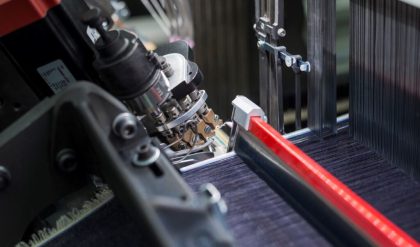
Sustainability in itself is a very broad topic that’s initially crucial in helping reduce the effects of climate change on our Earth. To achieve sustainability in major industries, the production processes must be reconstructed to fit the needs of both the consumers and the environment.
For the last 150 years, human-related activities have been, and will probably continue to be, the largest contributors to the greenhouse gases that trap heat in the atmosphere and make the planet warmer, leading to climate change. And the fashion industry accounts for around 10 percent of greenhouse gas emissions that stem from human activity, in addition to using around 93 billion cubic meters of water each year — enough for the needs of five million people. So, how can we, as individuals, help reduce the impact fashion has on the climate?
Fast fashion numbers
Most of the clothes we buy end up in landfills. On average, 10 million tons of clothing end up in landfills every year. This is a staggering amount of waste, of not only the gas emissions that are produced in the manufacturing process of these clothes but also the further emissions that the clothes release as they decompose. But that’s not all. According to the United Nations Environment Programme (UNEP), it takes around 3,780 liters of water to produce just one pair of jeans, and one-fifth of the global wastewater produced yearly comes from the fashion industry.
We have been wearing clothes ever since the dawn of humanity, so why has this become a problem now? It is largely because of the rise of fast fashion. New clothing lines and trends were once launched seasonally. Now, potential buyers are offered new trends every week, and at a much lower cost
According to the Ellen MacArthur Foundation, around 50 billion new garments were made in total in 2000. Today, that figure has doubled, and the average person today buys 60 percent more clothing than in 2000. Buying more also means throwing away more.
With modern technologies and cheap materials, fast fashion has become the norm. As consumerism keeps feeding the fashion industry, people have started leaning more and more towards fast fashion. And even though approximately 72 percent of these clothes contain non-biodegradable plastics and synthetic fibers such as polyester, acrylic, nylon that are made from fossil fuels, they stay in high demand due to their cheap price tags.
One of the negative results of fast fashion is that consumers today prefer quantity over quality, which leads to the prevalence of single-use items being in landfills around the world. What’s especially worrisome is the underlying psychology that makes fast fashion addictive. For some, over-purchasing and other materialistic tendencies are linked to decreased life satisfaction, happiness, vitality, and social cooperation and increased depression, anxiety, racism, and antisocial behavior. According to the BBC, about five percent of the population exhibits compulsive buying behavior to fulfill their needs to be accepted by society.
But this is not the full story. Because fast fashion companies have a range of tactics they use to constantly encourage us to purchase much more clothing than they need.
By releasing new clothing lines constantly, fashion encourages us to think that whatever clothing we have is constantly ‘out of fashion,’ and that there is something new we must have instead.
The low prices of fast fashion are also intentional. For these businesses, it’s all about volume. But psychologically, we tend to place less value on something that is cheap to purchase. So, if it’s poorly made or wears out quickly, we don’t tend to mind.
So what can be done to make fashion a more sustainable industry?
Sustainable fashion technology
Fashion can indeed be sustainable – with the right technology.
One aspect of sustainable fashion is the use of biodegradable, sturdy, and locally-produced materials that come with fewer carbon emissions in their production. By sticking to these products, we may be able to reduce fashion’s damaging effects on the environment and produce longer-lasting clothes that can be recycled and reused for longer periods of time, creating a more circular industry.
Major fast fashion brands, including Sweden-based H&M, have also released campaigns supporting eco-fashion, even while continuing to operate on a fast-fashion model.
While many designers, brands, and scientists are trying to find ways to make fashion more sustainable and circular, another way to turn the tide around in the fashion industry can be using the technology and the rapid digitization of the supply chain at hand.
To create a piece of clothing, fashion houses tend to require tens of samples. Using 3D virtual sampling can eliminate the need for physical samples and put an end to fabric waste while reducing carbon emissions. Human error also plays a major role in the emergence of excess fabrics during the designing process of clothes, but taking the modeling stage into the digital setting can help designers work with ease with little waste, reduced water use, air pollution, and water contamination.
Renewed interests in wearable technology, paired with democratization and the cost drop of 3D printers have allowed fashion designers to look to 3D printing as another creative medium. From the middle of the road fashion labels to high-end couture fashion houses, this industry stands to benefit a lot from 3D printing.
Fashion designers can turn 3D printing into a playground where they can try out innovative designs and recyclable clothes. Without limits, they can unleash their creativity which results in exciting works.
Some brands have also used 3D printing to move their designs from the digital setting into the real world. A notable example is the well-known Dutch fashion designer Iris Van Herpen that has previously made headlines in the fashion world with her experimental haute couture collections that combine traditional designs with laser cutting, digital fabrication, and 3D printing. Van Herpen is now working with her team to develop sustainable textiles.
Scientists and engineers have been also using modern technology to create new, updated fabrics that are both eco-friendly, sustainable, and unique. The most notable examples of novel fabrics are faux-leather options made using materials such as cacti, pineapple leaves, apple resin, and seaweed fibers. Through sustainable fabrics, we could eliminate the need for plastics-based and non-biodegradable fibers in manufacturing. These appealing technological trends could one day become the future of the fashion industry.
Another popular technologic development in the fashion scene within the last decade has been undeniably AI. Through AI, fashion brands can easily improve customer experiences, analyze and predict trends, and even keep track of buying patterns. AI can also be taught to learn and understand the fashion aesthetics, color, texture, and style preferences of the buyers. By reading this data, brands can manufacture only the models that are popular with their audience and prevent excess production waste.
While these tech-driven efforts can help ease the major transition of the fashion industry as a whole, if customer behavior doesn’t change in the upcoming decade, these preventative measures won’t have much of an impact.
By buying fewer clothes, choosing recyclable clothes made from natural materials, holding onto them for longer, or swapping clothes with others instead of constantly buying new items, individuals can do a lot to make fashion more sustainable. The future of fashion relies on innovative thinkers.
